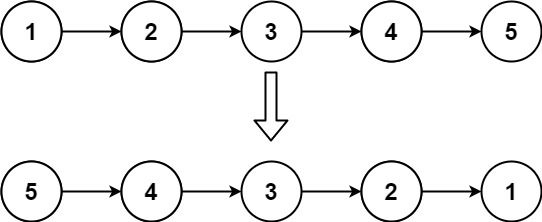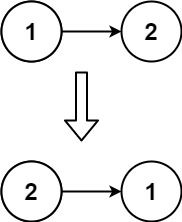给定单链表的头节点 head ,请反转链表,并返回反转后的链表的头节点。
注意:本题与主站 206 题相同: https://leetcode.cn/problems/reverse-linked-list/
定义指针 p、q 分别指向头节点和下一个节点,pre 指向头节点的前一个节点。
遍历链表,改变指针 p 指向的节点的指向,将其指向 pre 指针指向的节点,即 p.next = pre。然后 pre 指针指向 p,p、q 指针往前走。
当遍历结束后,返回 pre 指针即可。
# Definition for singly-linked list.
# class ListNode:
# def __init__(self, x):
# self.val = x
# self.next = None
class Solution:
def reverseList(self, head: ListNode) -> ListNode:
pre, p = None, head
while p:
q = p.next
p.next = pre
pre = p
p = q
return pre迭代版本:
/**
* Definition for singly-linked list.
* public class ListNode {
* int val;
* ListNode next;
* ListNode(int x) { val = x; }
* }
*/
class Solution {
public ListNode reverseList(ListNode head) {
ListNode pre = null, p = head;
while (p != null) {
ListNode q = p.next;
p.next = pre;
pre = p;
p = q;
}
return pre;
}
}递归版本:
/**
* Definition for singly-linked list.
* public class ListNode {
* int val;
* ListNode next;
* ListNode(int x) { val = x; }
* }
*/
class Solution {
public ListNode reverseList(ListNode head) {
if (head == null || head.next == null) {
return head;
}
ListNode res = reverseList(head.next);
head.next.next = head;
head.next = null;
return res;
}
}/**
* Definition for singly-linked list.
* function ListNode(val, next) {
* this.val = (val===undefined ? 0 : val)
* this.next = (next===undefined ? null : next)
* }
*/
/**
* @param {ListNode} head
* @return {ListNode}
*/
var reverseList = function (head) {
let pre = null;
for (let p = head; p; ) {
let q = p.next;
p.next = pre;
pre = p;
p = q;
}
return pre;
};/**
* Definition for singly-linked list.
* type ListNode struct {
* Val int
* Next *ListNode
* }
*/
func reverseList(head *ListNode) *ListNode {
var pre *ListNode
for p := head; p != nil; {
q := p.Next
p.Next = pre
pre = p
p = q
}
return pre
}/**
* Definition for singly-linked list.
* struct ListNode {
* int val;
* ListNode *next;
* ListNode() : val(0), next(nullptr) {}
* ListNode(int x) : val(x), next(nullptr) {}
* ListNode(int x, ListNode *next) : val(x), next(next) {}
* };
*/
class Solution {
public:
ListNode* reverseList(ListNode* head) {
ListNode* pre = nullptr;
ListNode* p = head;
while (p) {
ListNode* q = p->next;
p->next = pre;
pre = p;
p = q;
}
return pre;
}
};/**
* Definition for singly-linked list.
* public class ListNode {
* public int val;
* public ListNode next;
* public ListNode(int val=0, ListNode next=null) {
* this.val = val;
* this.next = next;
* }
* }
*/
public class Solution {
public ListNode ReverseList(ListNode head) {
ListNode pre = null;
for (ListNode p = head; p != null;)
{
ListNode t = p.next;
p.next = pre;
pre = p;
p = t;
}
return pre;
}
}

